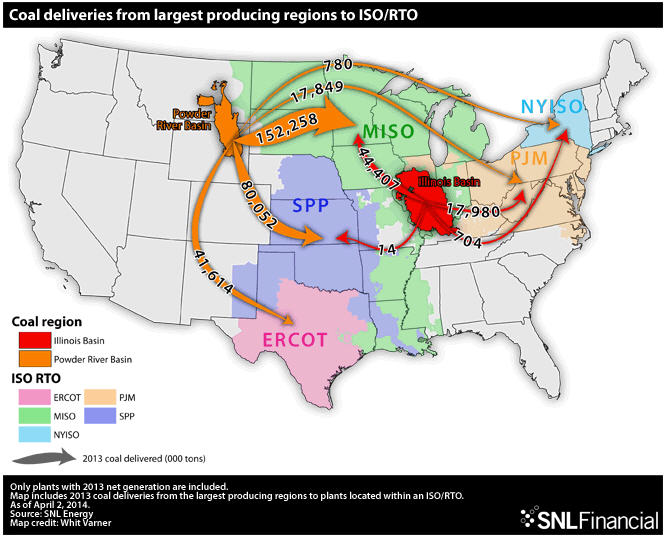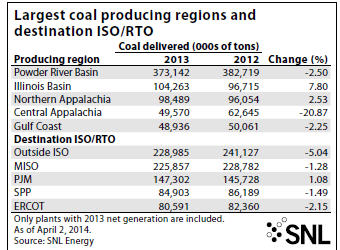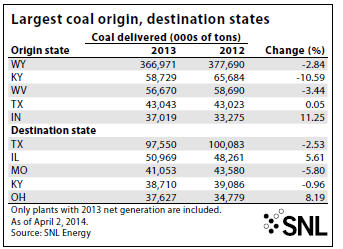US coal demand slipping, but some basins faring better than others
Coal remains the largest source of fuel for electric generation in the United States. However, demand is shrinking. According to SNL Energy’s analysis of fuel delivery data from monthly Form EIA-923 filers, roughly 779 million tons of coal were delivered to domestic power plants in 2013, a drop of 1.75% compared to coal deliveries in 2012.
Filed by power generators, the monthly EIA 923 filing details generation and fuel deliveries, among other information.
The majority of coal delivered to power plants now comes from the Powder River Basin region, as power generators have shifted away from more expensive Central Appalachian coal. Yet the PRB saw a slowdown in deliveries in 2013, delivering a total of 373 million tons of coal to power plants, a decline of 2.5% compared to 2012. Plants within the nation’s ISO and RTO regions were the destination for almost 70.61% of the coal deliveries in 2013. ISO or RTO regions are wholesale power markets and do not include many states in the Southeast and West.
MISO region remains largest coal demand center
The Midcontinent Independent System Operator Inc., the largest among all the ISO and RTO regions in terms of 2013 coal deliveries, received the majority of its coal from the PRB and Illinois Basin. In 2013, about 67.41% of coal delivered to plants in MISO originated from the PRB, a decrease compared to 2012 when PRB coal accounted for 68.63% of total deliveries. The Illinois Basin, meanwhile, saw its share of deliveries to MISO increase to 19.66% in 2013 from 17.72% in 2012.
The 2,453-MW Labadie power plant in MISO, located in Missouri, received the largest amount of coal among all plants in the region in 2013. The plant got all of its 9.5 millon tons of coal from the PRB.
The PRB also accounted for the majority of all the coal delivered to power plants in the Southwest Power Pool region. Of the 84.9 million tons of coal delivered to SPP plants in 2013, about 80 million tons — or 94.29% — came from the PRB. The basin accounted for 94.87% coal deliveries to SPP plants in 2012.
For plants in the Electric Reliability Council of Texas Inc. region, which had aggregate coal deliveries of 80.6 million tons in 2013, 51.63% of the coal came from the PRB.
The Illinois Basin was the second-largest source of coal for domestic power production in 2013 as demand for the region’s coal continues to grow. The region delivered almost 104.3 million tons of coal to power plants during the year, an increase of 7.8% compared to 2012. More than 42.59% of the basin’s coal went to plants in the MISO region, while 17.24% of deliveries were to plants in the PJM Interconnection region.
Wyoming leads all other states in coal supply by wide margin
Looking at major coal origin states, almost 367 million tons, or 47.09%, of the total coal delivered in the U.S. originated from Wyoming in 2013. Campbell County in Wyoming was responsible for delivering 88.64% of the toal coal delivered from the state. Black Thunder, owned by Arch Coal Inc., and Peabody Energy Corp.‘s North Antelope Rochelle mines were the major contributors. The majority of the coal from mines in Wyoming went to plants in MISO.
Kentucky was a distant second in terms of coal delivered in 2013, with deliveries of 58.7 million tons from mines in the state. The state had a 10.59% decrease in deliveries compared to 2012 as it saw a large number of coal mines idled. Kentucky delivered 58.95% of its coal to power plants outside any ISO or RTO region in 2013 while 30.49% of coal from the state went to plants in the PJM.
Among the largest coal destination states, Texas tops the list, with 97.6 million tons of coal delivered to the state’s power plants in 2013, a decrease of about 2.5 million tons compared to 2012. Mines in the PRB were responsible for 55.88% of the coal delivered to Texas plants, while the remainder of deliveries came from the nearby Gulf Coast region.
The 2,455-MW Martin Lake power plant in Rusk County received the largest amount of coal among all plants in Texas during the year. The plant took 11.5 million tons of coal in 2013, with 8.8 million tons, or 77%, coming from the Gulf Coast region and 2.6 million tons, or 23%, from the PRB.
More News
{{ commodity.name }}
{{ post.title }}
{{ post.date }}






Comments